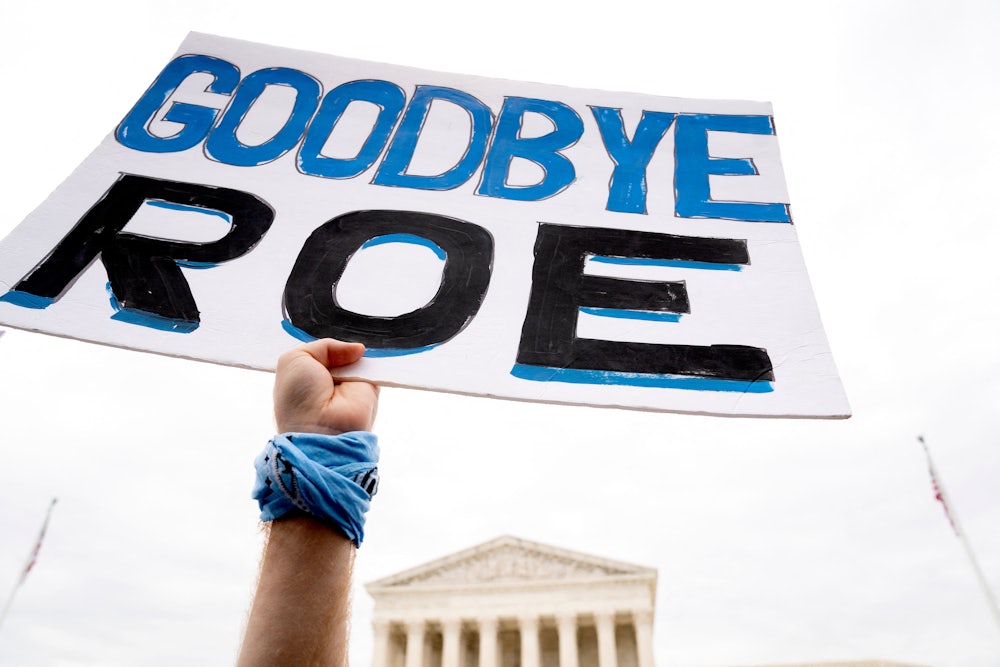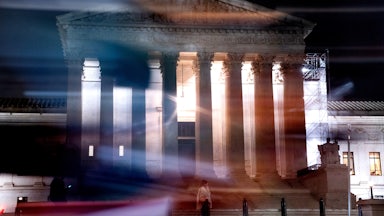The Supreme Court is poised to overturn Roe v. Wade. This outcome is the culmination of five decades of fervent activism and mobilization at the polls, which begat a stacked federal bench of conservative judges and state legislatures brimming with lawmakers willing to outlaw abortion. But while abortion opponents have cultivated a movement that became central to the Republican Party and its victories, Democrats—particularly on the federal level—appear to have been caught off guard by the slow but inexorable progress of that cause.
With the election of President Donald Trump and the promise of appointing more conservative jurists to the Supreme Court—indeed, three Trump-nominated justices now sit on the court—Republican-led states were further emboldened to prepare and enact legislation restricting or outright banning the right to an abortion. One such law in Mississippi banning abortion after 15 weeks became the basis of Dobbs v. Jackson Women’s Health Organization, the case before the Supreme Court presenting the opportunity to overturn Roe. The Supreme Court has already allowed an even more stringent and controversial Texas law outlawing abortion after six weeks to go into effect. According to the Guttmacher Institute, which supports abortion rights, 26 states are certain or likely to ban abortion if Roe is overturned.
Senator Elizabeth Warren noted to me that conservative judicial nominees had professed, during their confirmation hearings, that they held Roe to be a matter of settled law. “Democrats may have believed or at least wanted to believe the judicial nominees who swore they wouldn’t touch Roe, and didn’t make it a first priority in every political rally and every vote. We’ve now seen the consequences of that,” Warren said. “But let’s be clear: The blame here is not about Democrats, it’s about Republicans who are determined to advance a right-wing agenda that is not supported by the overwhelming majority of Americans and to do it through the courts because they know they can’t do it through Congress.”
Abortion opponents have invested heavily in their cause for decades, making inroads into the judiciary and state legislatures. Democrats, and by extension abortion rights supporters, can now turn their attention to those new battlefields. But for the federal right to an abortion, those efforts may come too late.
The GOP was not always the party of abortion opponents, and abortion rights supporters did not always flock to Democrats. Michele Goodwin, a professor at the University of California, Irvine, School of Law, argued that the Republican Party had adopted the language of the anti-abortion movement because of its messaging power and as a way to obtain those opponents as part of its base, capitalizing on their enthusiasm. “This has been politically expedient, to utilize abortion as a wedge issue,” Goodwin said.
When Roe was decided, Catholics who opposed abortion comprised a core demographic for Democrats; meanwhile, several Republican governors, including then–California Governor Ronald Reagan, had signed legislation easing restrictions on abortion in the late 1960s and early 1970s. Roe itself was decided with a 7–2 majority, with a Nixon-nominated justice writing the opinion.
It took decades for party positions on abortions to calcify. As the Republican Party slowly adopted opposition to abortion into its platform and Democrats became the party of abortion rights supporters, those on either side of the issue began to self-select, Daniel Williams, a history professor at the University of West Georgia, told me. This resulted in politicians moving to the left or the right on abortion based on their respective parties, or switching parties entirely. Furthermore, as white evangelicals became a core constituency of the Republican Party in the 1980s, opposition to abortion became more central to the party’s platform.
“Because of their outsize influence on the Republican Party, particularly in the South, and because of their importance in bringing formerly Democratic states or swing states in the South into the Republican coalition, the fact that they cared about abortion meant that it would become very difficult for the Republican Party to move away from its anti-abortion stance,” Williams, who has written books on the Christian right and the pre-Roe movement against abortion, told me.
Goodwin argued that white evangelicals began turning to the Republican Party and emphasizing the need for a conservative Supreme Court in the wake of new laws and court decisions that expanded civil rights. “At a certain point, there was a sense that there could be some political gain and advantage by coalescing with these forces,” Goodwin said. Key evangelical leader Jerry Falwell, for example, spoke out against Brown v. Board of Education and fumed when the tax-exempt status of his segregated Christian school was threatened. Falwell’s Moral Majority was pivotal in electing Ronald Reagan in 1980, and galvanized supporters by tying anti-abortion sentiment to other conservative causes like opposition to the gay rights movement and restoring school prayer.
Abortion opponents began to transition to a judicial strategy in the early 1980s, Williams told me, after the Senate failed to approve the Hatch-Eagleton Amendment. This would have amended the Constitution to say that the right to an abortion was not constitutionally guaranteed, but it failed to garner sufficient votes, with opposition from some Republicans as well as Democrats. (Thomas Eagleton, one of the sponsors of the amendment, was a Democrat.) “The pro-life movement then consciously shifted—there were actual strategy discussions on this among leaders in the National Right to Life Committee and elsewhere—[they] consciously shifted toward a strategy of changing policy through the Supreme Court rather than through a constitutional amendment,” Williams said. But that strategy also made it harder for Democrats who opposed abortion to remain a part of the movement: Even if they supported a nominee’s position on abortion, an otherwise liberal Democrat would have qualms about confirming ultraconservative judges.
Mary Ziegler, a professor at Florida State University College of Law who has written several books on abortion history, said that it was not enough for the anti-abortion movement to have conservative justices confirmed to the Supreme Court. Republican-nominated justices helped to uphold the right to an abortion in the 1992 ruling of Planned Parenthood v. Casey. “I think there was a real sense after Casey, the 1992 decision, that justices who were worried about popular opinion or about backlash would probably not overrule Roe. So you needed to have a particular kind of conservative who was not concerned about that sort of thing,” Ziegler told me.
As Ziegler outlines in her new book, there was further a connection between the anti-abortion movement and efforts to ease campaign finance restrictions; wanting to influence more Republicans to oppose abortion, figures like James Bopp, the general counsel of the National Right to Life Committee, fought to increase their capacity for campaign finance spending. Bopp was the first lawyer to represent the organization Citizens United in the case that ended up before the Supreme Court, resulting in the ruling that corporations could give money to political action committees.
By the time Trump was elected, opposition to abortion was a core element of the Republican Party, and white evangelicals were a central constituency. Then–Senate Majority Leader Mitch McConnell was successful in blocking President Barack Obama’s nominee to the Supreme Court, and the Supreme Court vacancy was an important motivator for many Trump voters. Trump was able to nominate three justices to the Supreme Court, thus justifying for many abortion opponents their decision to support him.
While abortion opponents were growing increasingly motivated by their opposition to Roe, and while they became more central to the Republican Party, Democrats were arguably becoming more complacent. “It’s often easier to be motivated when you’re fighting the status quo, rather than when you feel comfortable with the status quo,” Ziegler said.
If—or perhaps when—Roe is overturned, it will not be the end of the anti-abortion movement. Ziegler noted that ending the federal right to an abortion is not the endgame. Rather, it is ending abortion altogether. Moreover, there are some states in which majorities of voters favor abortion restrictions. “Regionally, in some House elections, Senate elections, state legislative or gubernatorial races, it’s a good thing that you can pass really punitive abortion laws,” Ziegler said. “In other Southern states and in some Midwestern states, because of a combination of polarization and gerrymandering, there’s no real downside to seeing criminal abortion bans.”
Congressional Republicans have largely avoided discussing a post-Roe world, but given indications of potential support for a federal abortion ban, if abortion continues to be red meat for the base, its power as a wedge issue will persist. As my colleague Matt Ford has written, the language in Justice Samuel Alito’s leaked draft decision could provide a template by which the Supreme Court’s conservative majority may bring about other goals of the conservative movement—perhaps even including banning contraception or reversing marriage equality.
Williams highlighted that abortions are already prohibitively difficult to obtain in the dozen or so states that have significantly restricted the procedure. In the other states that are likely to ban abortion if Roe is overturned, there are already few abortion providers. “By my estimate, even after more than 20 states substantially restrict or ban abortion, there would still be approximately 85 percent or more of the abortion providers that are currently in existence continuing to legally operate, just because we’ve already become so polarized regionally as a country on abortion access,” Williams said.
But neither will Democrats and abortion rights supporters go quietly into that good night. Some states are likely to expand abortion access or try to facilitate abortion access for people living in other states. If California wants to subsidize someone to come to Texas for an abortion, for example, that may be the next abortion-related fight coming before the courts, Williams predicted. State officials, like attorneys general, will also become critical figures in shoring up abortion rights and determining how abortion laws are enforced.
Democrats may also now be more fully aware of the power of the courts, and able to focus their energies on that battleground. “I think we’re now focused very, very clearly and urgently on the courts,” said Blumenthal. “Mitch McConnell managed to forestall a democratic appointee to the United States Supreme Court and then ram through the Trump appointee. He used tactics that were brazen and unprecedented. But we’re focusing on the courts now. We understand the urgency.” (Blumenthal introduced the Women’s Health Protection Act, which would guarantee the federal right to an abortion and was blocked by Senate Republicans last month.)
Still, it may be years before the response to the Roe decision is fully realized; after all, political opposition to Roe itself simmered for decades, only gradually building consensus and taking shape as a core mission of the Republican Party. A response may not be fully catalyzed until it becomes more apparent what life without abortion access means for millions of people: For example, it took 35 years before an amendment outlawing abortion in Ireland was repealed by a referendum. “We won’t know what kind of backlash we’re going to have in the 2022 election or in 2024,” Ziegler said. “Backlashes take a long time to develop.”
Whether or not the reaction among the populace is immediate, Democrats as a whole will learn a hard lesson on the importance of long-term political investments in an ideologically aligned judiciary. “Democrats are now highly aware of just how damaging an extremist court can be to every personal liberty that we hold dear,” Warren said.








